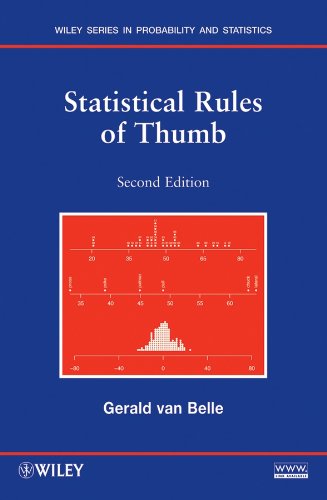Statistical rules of thumb pdf
Par easley mary le jeudi, mai 26 2016, 01:01 - Lien permanent
Statistical rules of thumb by Gerald van Belle


Statistical rules of thumb Gerald van Belle ebook
Format: pdf
Page: 305
Publisher: Wiley
ISBN: 0470144483, 9780470144480
It contains many well-chosen and motivating medical examples suitable for the audience, with statistical rules of thumb, non-technical explanations and fully worked example problems. With five minutes to speak to the publishers of many of the top science journals, I tried to distill the lessons learned about scientists and social media to a short set of “rules of thumb.” I was not surprised at all when the panel of scientists at the end of the day .. I won't argue the specific merits of the Berkeley study with you, statistical analysis of sociological studies is not my area of expertise. Despite decades of careful data collection and mathematical and statistical research, on many large questions we have little more than rules of thumb. (note: I live in CA, so get no money from these Amazon links). The P-Value: What it Really Means. As I perused Statistical Rules of Thumb again, as I do from time to time, I came across this gem. (In a day.) You get statistically relevant results. Snedecor -Statistical Methods, 8th ed. (And eat some cake.) You win the nobel prize for web genius. The P-value is one of the biggest sources of confusion in statistics, and it's not uncommon for researchers to use the wrong definition: not when they compute it, but when they think about it. Statistical Rules of Thumb, part II · Rexer Analytics data mining survey · Predictive Models are not Statistical Models — JT . (From your massive volume of site traffic.) You share the results with your team. Van Belle - Statistical Rules of Thumb. Haldane cites work on decision-making by the psychologist Gerd Gigerenzer. None of the three seem to follow the rule with any sort of consistency but they are all in the ballpark of the rule, but not by much. In terms of the variations – without knowing anything else specific to the site – 2-4 is a good rule of thumb and it's what I see most commonly. Sheshkin - Handbook of Parametric and Nonparametric Statistical Procedures. The numbers will follow but here are some takeaways (I didn't do any statistical analysis, this is just me eyeballing numbers and drawing conclusions that are probably not statistically significant): The rule of thumb is certainly good in terms of rules of thumb, I wouldn't follow it to the ends o f the Earth but it's definitely better than nothing. (And get a raise.) rain; You implement the winner. As a rule of thumb, this means that your sample size multiplied by your proportion estimate is greater than ten, and that your sample size multiplied by the opposite of your proportion estimate is also greater than ten.